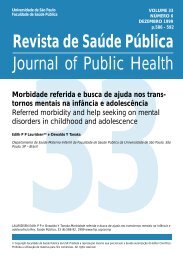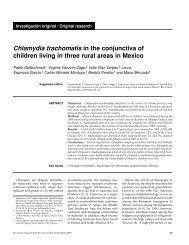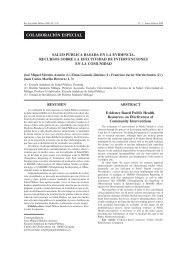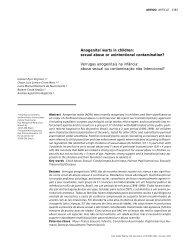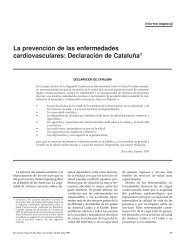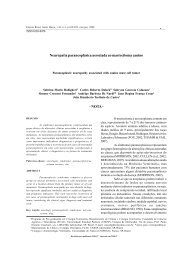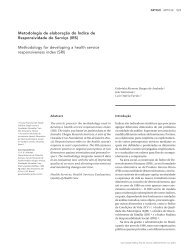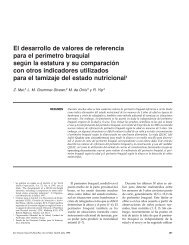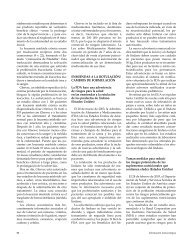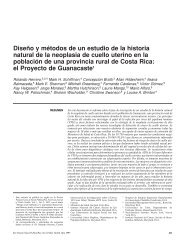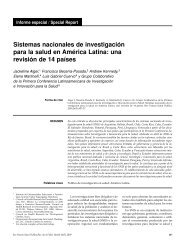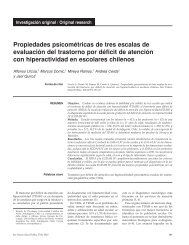Nível de atividade física de crianças e adolescentes órfãos ... - SciELO
Nível de atividade física de crianças e adolescentes órfãos ... - SciELO
Nível de atividade física de crianças e adolescentes órfãos ... - SciELO
Create successful ePaper yourself
Turn your PDF publications into a flip-book with our unique Google optimized e-Paper software.
Tabela 2 - Distribuição total das variáveis socio<strong>de</strong>mográficas, brinca<strong>de</strong>iras e tempo inativo estratificada pela<br />
categorização da prática <strong>de</strong> ativida<strong>de</strong> <strong>física</strong> das <strong>crianças</strong> e <strong>adolescentes</strong> <strong>órfãos</strong> em <strong>de</strong>corrência da aids segundo<br />
características socio<strong>de</strong>mográficas e relativas a orfanda<strong>de</strong>. Município <strong>de</strong> São Paulo, 2007.<br />
Table 2 - Overall distribution of socio-<strong>de</strong>mographic, playing and inactivity time variables stratified by category of physical<br />
activity of children and adolescents according to socio-<strong>de</strong>mographic and orphanhood-related characteristics. Municipality of<br />
São Paulo, 2007.<br />
Variável < 300 min ≥300 min<br />
Características socio<strong>de</strong>mográficas n % IC(95%) n % IC(95%)<br />
Sexo<br />
Masculino 31 (30,0) (22,3;39,2) 77 (58,0) (48,8;66,7)<br />
Feminino 69 (70,0) (60,8;77,7) 58 (42,0) (33,2;51,2)<br />
p = 0,000*<br />
Ida<strong>de</strong> (anos)<br />
07 – 10 36 (35,2) (26,6;44,9) 41 (29,7) (20,9;40,4)<br />
10 – 13 34 (34,1) (26,7;42,4) 62 (46,3) (38,3;54,6)<br />
13 – 15 30 (30,7) (22,7;40,0) 32 (24,0) (16,3;33,6)<br />
p = 0,194<br />
Cor <strong>de</strong> pele<br />
Branca 45 (46,7) (34,6;59,2) 54 (41,5) (33,1;50,5)<br />
Não branca 55 (53,3) (40,8;65,3) 81 (58,5) (49,5;66,9)<br />
p = 0,4105<br />
Condição sorológica<br />
Soropositivo para o HIV 5 (4,9) (1,7;12,5) 7 (5,9) (2,8;11,7)<br />
Soronegativo para o HIV 70 (71,5) (58,9;81,4) 95 (67,6) (57,1;76,5)<br />
Não sabe a condição sorológica 25 (23,6) (14,6;35,9) 33 (26,5) (18,5;36,5)<br />
p = 0,828<br />
Tipo <strong>de</strong> orfanda<strong>de</strong><br />
Órfão paterno 55 (46,4) (36,1;57,0) 64 (50,4) (40,7;60,0)<br />
Órfão materno 30 (28,1) (19,9;38,0) 38 (29,8) (21,6;39,7)<br />
Órfão ambos 28 (25,5) (16,8;36,8) 25 (19,8) (12,6;29,6)<br />
p = 0,5482<br />
Tipo cuidador<br />
Um dos pais 49 (49,8) (38,7;61,0) 60 (44,7) (34,2;55,7)<br />
Outros familiares 42 (41,2) (28,9;54,6) 62 (44,6) (33,8;55,8)<br />
Não familiares 9 (9,0) (4,6;17,0) 13 (10,7) (5,8;18,9)<br />
p = 0,760<br />
Escore econômico<br />
Escore 1 (P25) 34 (33,6) (22,4;46,9) 41 29,3 (20,5;40,0)<br />
Escore 2 (P50) 20 (22,0) (12,1;36,7) 42 30,4 (21,3;41,3)<br />
Escore 3 (P75) 43 (44,4) (33,0;56,3) 50 40,3 (30,3;51,1)<br />
0,4198<br />
Renda per capita<br />
< R$ 380,00 80 (82,5) (71,1;89,9) 106 (85,3) (76,0;91,4)<br />
≥ R$ 380,00 15 (17,5) (10,0;28,9) 17 (14,7) (8,6;23,9)<br />
p = 0,577<br />
Anos <strong>de</strong> estudo n % IC(95%) n % IC(95%)<br />
0-4 43 (43,5) (31,2;56,7) 52 (37,3) (27,6;48,1)<br />
5-9 26 (26,8) (17,4;38,8) 48 (35,7) (27,3;45,0)<br />
> 9 31 (29,7) (21,6;39,3) 35 (27,0) (19,0;36,9)<br />
p = 0,374<br />
<strong>Nível</strong> <strong>de</strong> ativida<strong>de</strong> <strong>física</strong> <strong>de</strong> <strong>crianças</strong> e <strong>adolescentes</strong> <strong>órfãos</strong> por aids<br />
Barros, C.R.S. et al.<br />
451<br />
Rev Bras Epi<strong>de</strong>miol<br />
2010; 13(3): 446-56





